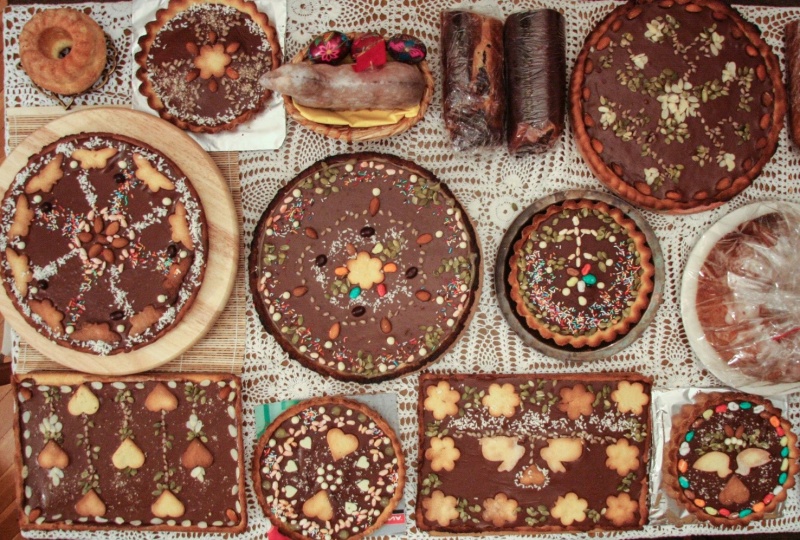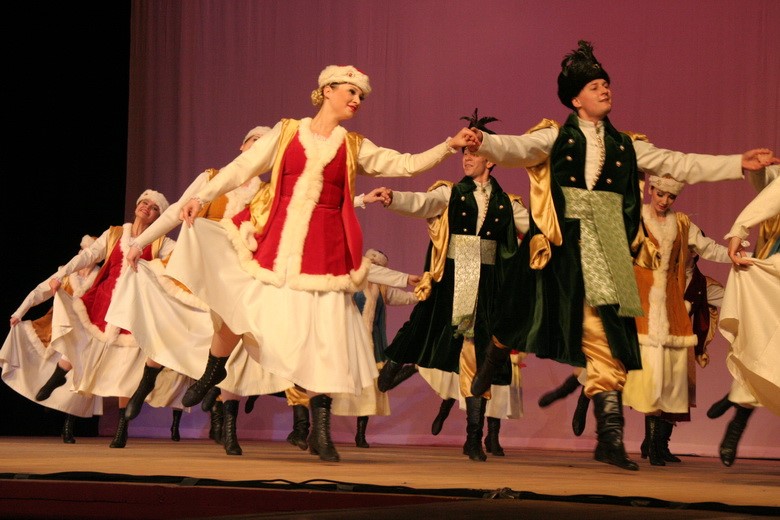Mazurka and mazurek are inextricably linked with Polish culture and tradition. Mazurek is a flagship Polish Easter cuisine dish – no Easter table can be without this shortcrust based cake, brimming with dried fruits and nuts, lavishly doused in icing and its delicious rolled half-short pastry edges. It is baked in rectangular and oval cake pans – the latter reminiscent of Easter eggs. There are a number of varieties of this cake. These include royal mazurek (also known as traditional) with almonds and confiture (poppyseed filling, chocolate and nuts are all optional), classic chocolate mazurek, dulce de leche mazurek – topped with finger licking dulce de leche (also known as fudge topping), nut mazurek – with various types of nuts, both as a filling paste and as garnish on top of the cake, as well as lemon or orange mazureks. Once the topping on this cake sets, it is adorned with traditional Eastern decorations and icing. The plethora of methods for baking and decorating this pastry means that each mazurek is exceptional and unique. The symbolism of this cake is closely related with Lent. Once the obligatory forty day abstinence from sweets, pastries and meat is over, mazurek is a delectable award for those who managed to show restraint. .

The recipe for mazurek most probably has Oriental roots – it is said to have arrived to Poland from the Ottoman Empire and made a permanent home here in our native tradition by the 17th century. Poland's modern history is inextricably linked with that country. The periods when Poland was at war with the Turks were interspersed with times when trade between the two countries flourished. Dried fruits and nuts were one of the Ottoman Empire's export products. Pastries covered with Turkish dulce de leche and dried dates, raisins, figs, almonds, nuts or prunes were becoming ever more popular and appreciated. And this gave rise to the story of mazurek. The etymology of the cake's name is also noteworthy. It may (similar to the name of the Polish national dance) have its origins in the old Polish term for a person living in the Mazovia region – Mazur. These were the descendants of a tribe of Mazovian settlers who lived in lands part of the Dutchy of Prussia since the 12th century.

The history of the mazur, one of the five national Polish dances (which also include kujawiak, polonaise, oberek and krakowiak) probably dates back to the 16th century. According to the memoirs of Jan Chryzostom Pasek, a Polish nobleman, one can deduce that the dance was popular amongst the Polish nobility already during the reign of John Casimir, however not as much as the krakowiak. Some researchers indicate peasant origins of mazur's protoplast, known in the countryside as mazurka and popular across the Mazovian Lowlands. However, here the terminology is not conclusive. The name mazurka was used to refer to a fast type of oberek, and in the Kujawy region it meant the last part of kujawiak. It was also referred to as the drobny and wyrywas dance.
In the first half of the 17th century, rhythms typical for the mazur began appearing in musical compositions. However, there are no descriptions of movements which might make it possible to connect those with a dance known from that epoch. The mazur gradually migrated to courts and became saturated with a plethora of movements which made it stand out from other dances. We know of the spread of the mazur to other countries in the 18th century from records of a ball taking place in 1738 in Naples, at the court of Princess Maria Amalia of Saxony, to celebrate her marriage to Charles III of Spain, King of Naples and the future King of Spain. Moreover, the Elector of Saxony himself and Polish King during 1697-1706 and 1709-1733, Augustus II the Strong, contributed to the introduction of the mazur to German courts. After the demise of the Republic of Poland, this dance gained popularity in Russian territories, both among the nobility and peasants. Three-dimensional rhythm with an accent on the second or third bar, a wealth of dance figures, spatial movements and fast tempo require the dancers performing it to be highly skilful and able. Mazur's steps are often complemented by decorative elements and dynamic accents such as a hułubiec (clicking of the heels with a simultaneous jump) or stamping. The individual figures of the dance, although choreographed in advance, are full of improvisations by each dancer. By the end of the 18th century, mazurs became a permanent feature on ballet stages. The mazur was most popular during the Congress Kingdom, with an emphasis on the 1820s and 1830s, when it replaced the polonaise. However, from the late 1830s onwards, the mazur gradually began to give way to the waltz thanks to the work of eminent composers of dance music such as Johann Strauss I and Joseph Lanner. Despite this fact, a significant decline in the popularity of the mazur as a dance only took place in the early 20th century. Nevertheless, the mazurka, a stylized musical form based on the mazur, continued to enjoy unflagging recognition and adoration by its listeners.
Mazowsze folk ensemble's magnificent rendition of a traditional Polish national mazur
All three Polish folk mazurka-type rhythm dances, kujawiak, oberek and last but not least the mazur may be used as the basis for a mazurka choreographed dance. Even though all of them are in the same meter (3/4, with 3/8 an option for the mazur), they are noticeably different. And I do not mean just the tempo, which varies from a slow lento or largetto to a quick allegro or vivace, but also their character and appearance. These differences have contributed to mazurka's inherent diversity, clearly seen in the works of Fryderyk Chopin, who composed as many as 57 piano pieces of this type. His mazurkas in C major Op. 56 No. 2 or C major Op. 68 No. 1, were composed in a way that perfectly reflects the typical characteristics of the mazur, and the mazurka in F major Op. 68 No. 3 is undoubtedly a thoroughbred kujawiak. The most outstanding continuators of the piano mazurka school developed by Fryderyk Chopin included the Russian composer Aleksander Scriabin (23 mazurkas composed between 1884 and 1903), Milij Balakirev (he composed at least 7 mazurkas, but was more valued for his works for orchestra) and Karol Szymanowski (his fascination with folklore was a very important stage in his career, he composed, among others, a collection of twenty mazurkas Op. 50 in 1924-1925).
Mazurka in F major Op. 68 No. 3 by Christoph Zbinden
Undoubtedly the most famous mazur stylisations as far as Polish classical symphonic music is concerned are those from the first act of "Halka" and the fourth act of "The Haunted Manor" composed by Stanisław Moniuszko, the creator of Polish national opera. Both of these masterpieces are undoubtedly among the best known works in the composer's repertoire, and to this day they still delight with their energy, great orchestration and monumentalism..
The piece from Stanisław Moniuszko's "Halka" referred to above, superbly performed by Lublin Philharmonic Orchestra conducted by Agnieszka Kreiner
Many wonderful mazurkas for orchestra were also composed by foreign composers, fascinated by its phenomenon and melodiousness. Mazurka has become immensely popular in the French territories. Jacques Offenbach, one of the most outstanding ballet and operetta composers in history, included a mazurka in his famous "Gaîté Parisienne", and the one composed by Léo Delibes appears several times in the first act of his masterpiece, the ballet "Coppélia".
The famous mazurka from the first act of "Coppélia" performed by the Bolshoi Theatre Orchestra and Ballet (2011)
Adam Bielecki
Sources:
- https://podroze.se.pl/aktualnosci/swieta-wielkanocne-2013-mazurek-skad-t/2273/
- Konarzewska, M., Technologia gastronomiczna z towaroznawstwem: podręcznik do nauki zawodu kucharz w technikum i szkole policealnej. Volume 2, Wydawnictwa Szkolne i Pedagogiczne, Warsaw 2011
- Downes, S., "Mazurka". The New Grove Dictionary of Music and Musicians, London 2001
- Kolberg, O., Lud: jego zwyczaje, sposób życia, mowa, podania, przysłowia, obrzędy, gusła, zabawy, pieśni, muzyka i tańce. Vol. 2, Kujawy, Seria 4, Warsaw 1867
- Brodziński K., O tańcach narodowych (polonez, krakowiak, mazurek, kozak), Warsaw 1828
- Swartz, A., “The Polish Folk Mazurka”. Studia Musicologica Academiae Scientiarum Hungaricae, Vol. 17, Akadémiai Kiadó, Budapest 1975
- Tomaszewski M., Chopin. Człowiek, dzieło, rezonans, PWM publishing house, Kraków 2005
- Prosnak, J., Stanisław Moniuszko, Polskie Wydawnictwo Muzyczne, Kraków 1968
